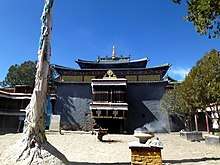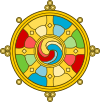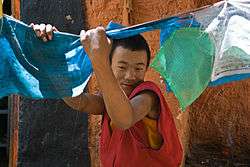Shalu Monastery
Shalu Monastery (Tibetan: ཞྭ་ལུ།, Wylie: zhwa lu ) is small monastery 22 kilometres (14 mi) south of Shigatse in Tibet. Founded in 1040 by Chetsun Sherab Jungnay, for centuries it was renowned as a centre of scholarly learning and psychic training and its mural paintings were considered to be the most ancient and beautiful in Tibet. Shalu was the first of the major monasteries to be built by noble families of the Tsangpa during Tibet's great revival of Buddhism, and was an important center of the Sakya tradition.
| Shalu Monastery | |
|---|---|
Tibetan transcription(s) Tibetan: ཞྭ་ལུ། Wylie transliteration: Zhwa-lu Official transcription (China): Xalu THL: Zhalu Other transcriptions: Shalu Chinese transcription(s) Traditional: 夏魯寺 Simplified: 夏鲁寺 Pinyin: Xiàlǔ Sì | |
 | |
| Religion | |
| Affiliation | Tibetan Buddhism |
| Sect | Shalu Sakya |
| Location | |
| Location | Shigatse Prefecture, Tibet, China |
| Architecture | |
| Founder | Chetsun Sherab Jungnay |
| Part of a series on |
| Tibetan Buddhism |
|---|
 |
|
|
|
Practices and attainment |
|
Institutional roles |
|
History and overview |
History


In 1329 a devastating earthquake demolished the temple of Shalu but was later rebuilt in 1333 by local lords under the command of Toghon Temür, last Khagan of the Mongol Empire. The new architectural framework of the monastery was dominated by Mongolian styles, with massive inward-sloping walls around a main courtyard and strong woodwork and glazed roof tiles from Qinghai.
At the time of the new establishment in the 1330s, Shalu Temple was under the command of the 11th Abbot, Buton Rinchen Drub, who lived 1290–1364. Buton was not merely a capable administrator but he is still remembered to this very day as a prodigious scholar and writer of the Sakya school and is Tibet's most celebrated historian. Buton catalogued all of the Buddhist texts at Shalu, some 4569 religious and philosophical works, and formatted them in a logical, coherent order. He also wrote the famous History of Buddhism in India and Tibet there, which many Tibetan scholars use in their study today.
Buton's activity inevitably attracted a great deal of attention to the monastery and brought in other Buddhist intellectuals from Tibet and India to study in the grounds amounting to some 3000 by 1360. After his death the monastery became an important centre of esoteric studies and Buddhist learning for centuries. Shalu Temple became known throughout the far east for its dedication to the study of Buddhist philosophy and practice.
By the 19th century, the monastery had become less influential and Tibetan scholars chose to study at the Gelug-dominated Samye, which had grown to be one of the most politically powerful in the Tibetan lands by this time. The monastery fell into ruin and little of the original 1330 structure remains, although the outer wall and the main building with damaged roofs still stands, and a number of 14th-century murals on the outer walls of the temple still follow an iconographic scheme developed by the great Buton himself. One of the murals is an allegory in which an elephant representing a human soul evolves through many steps and earthly trials to nirvana, becoming progressively white and purer in the cleansing process. Precise rules are still embedded into the walls on what the monks should wear, place their robes and how to behave in the central courtyard Deyangshar. Remnants of former mandala murals are concealed by over 100 thangkas, most of which were embroidered in Hangzhou, China in the 1920s.
Only two chapels of the Shalu temple are open to tourists today, although funds were allocated in 1995 for roof repair and the eventual restoration of the fine 14th-century structure by 2005.
Inside Shalu Monastery
Shalu Lakhang temple is in the centre of the monastery. On the ground floor, in the Tshomchen, Sakyamuni and his disciples are enshrined. The chapels flanking it house the Tanjur and the Kanjur books respectively. Chapels on the roof floor are typical Chinese blue tiled structures, housing Sakyamuni, Buton, and Arhats Buddhas. Massive delicate and old murals cover the walls of the monastery, mostly depicting stories from the life of the Buddha. Restoration and preservation are badly needed to protect those arts.
Inside Treasures
Shalu has four treasures which are of notable value. One is a sutra board, which is 700 years old and cannot be reassembled once broken apart, a piece of sutra printed against the board is regarded as good luck. Another is a brass urn, which is usually covered with a piece of red cloth and sealed; the holy water may clean 108 filths and is changed every 12 years. Another is a stone basin, which was the washbasin of the builder Chetsun Sherab Jungnay dating back to 1040; and another is a stone tablet, which was uncovered in the first construction of Shalu. The tablet displays a mantra which reads "om mani Padme Hum" and has four dagoba carved into it.
Repair and reconstruction
Repair and reconstruction of Shalu Monastery began on May 13, 2009, according to the Chinese government Xinhua online news. "The project, one of Tibet's biggest heritage renovation projects under the 11th Five Year Plan (2006–2010), involves reinforcement of its buildings, maintenance of sewage treatment facilities and improvement of fire and flood control systems", a prefectural government official said. It is planned to spend more than 16 million RMB yuan on the project.[1]
Notes
- "Archived copy". Archived from the original on 2009-05-17. Retrieved 2010-08-01.CS1 maint: archived copy as title (link)
External links
- Shalu Monastery - The Shalu Association
- Exhibition
Further reading
- Vitali, Roberto. 1990. Early Temples of Central Tibet. Serindia Publications. London. ISBN 0-906026-25-3. Chapter Four: "Shalu Serkhang and the Newar Style of the Yüan Court." Pages 89–122.
- von Schroeder, Ulrich. 2001. Buddhist Sculptures in Tibet. Vol. One: India & Nepal; Vol. Two: Tibet & China. (Volume One: 655 pages with 766 illustrations; Volume Two: 675 pages with 987 illustrations). Hong Kong: Visual Dharma Publications, Ltd. ISBN 962-7049-07-7. Zhwa lu («shalu») monastery, pp. 554, 922, 925, 1085, 1088, 1129: Zhwa lu gSer khang («shalu serkhang»), 554, 842, 922, 925; Figs. XIV–14–16, XV–8. Jo khang («jokhang»), p. 922; Pls. 47C, 229A, 230C, 231B, 231D, 314A, 329E. gNyer khang byang («nyerkhang chang»); Pls. 268C–D, 301A, 313A, 324E. gTsug la g khang («tsuglakhang»); Pl. 292A. Yum chen mo lha khang («yum chenmo lhakhang»), pp. 842–843; Figs. XIII–14–16. gZhal yas lha khang byang («shalye lhakhang chang»), pp. 439, 441, 913, 922; Figs. VII–3–4, XV–2; Pls. 169A, 169B, 229B, 229C, 230A, 230B, 231A, 231E, 322B. gZhal yas lha khang lho («shalye lhakhang lho»), pp. 922, 1129; Pls. 232B–C, 233B–C, 234B, 252D–F, 315A, 315B, 315C, 315D, 315E, 318D, 318E.